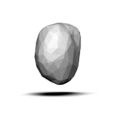Pisiform bone facts for kids
| Bone: Pisiform bone | ||
|---|---|---|
| Left hand anterior view (palmar view). Pisiform bone shown in red. | ||
| The left pisiform bone | ||
| Latin | os pisiforme | |
| Origins | Ulnar collateral ligament | |
| Articulations | Triangular | |
The pisiform bone is a small, round bone found in your wrist. It's shaped like a pea, which is where its name comes from (pisiformis means "pea-shaped" in Latin). This tiny bone helps form the edge of the carpal tunnel in your wrist.
Contents
What is the Pisiform Bone?
The pisiform is a special type of bone called a sesamoid bone. This means it's like a small, smooth pebble found inside a tendon. It doesn't have the usual outer covering that most bones have.
It's one of the eight carpal bones in your wrist. These bones are arranged in two rows. The pisiform is in the first row, closest to your arm. You can find it on the pinky-finger side of your wrist, near where your ulna bone connects.
How it Connects
The pisiform bone connects to only one other bone: the triquetral bone. This connection forms a joint. The pisiform sits a bit in front of the other wrist bones. It has four main surfaces:
- The back surface is smooth. It connects with the triquetral bone.
- The front surface is rough. Strong tissues like the transverse carpal ligament attach here. Muscles that move your hand also connect to this surface.
- The side surface (away from your body) is rough and curved inward.
- The middle surface (closer to your body) is rough and usually curved outward.
Where Did the Name Come From?
The word "pisiform" comes from the Latin word pīsum. This word means "pea." So, the bone is named for its small, round, pea-like shape.
What Does the Pisiform Bone Do?
The pisiform bone is like a small bump on the palm side of your hand. It helps form the "heel" of your hand.
It plays an important role in your wrist. It helps create the inner edge of the carpal tunnel. This tunnel is a narrow passageway in your wrist. Nerves and tendons pass through it.
The pisiform also serves as an attachment point for important muscles. These include the flexor carpi ulnaris and the abductor digiti minimi. These muscles help you move your wrist and pinky finger. The pisiform bone actually grows inside the tendon of the flexor carpi ulnaris muscle.
When the Pisiform Bone is Removed
Sometimes, if someone has a problem like osteoarthritis in the joint where the pisiform connects, doctors might remove it. Studies have shown that removing the pisiform can slightly change how much you can move your wrist. However, it usually doesn't stop people from doing their normal activities. Some people might feel a bit weaker when lifting very heavy things.
How the Pisiform Bone Developed
Compared to other animals like apes, humans have a shorter pisiform bone. Scientists think this change happened over a long time. It might have happened between early human ancestors like Australopithecus afarensis and later ones like Homo neanderthalensis.
In humans, the pisiform bone starts to harden and form between the ages of 7 and 12. This is called ossification. Scientists are still studying how genes might have influenced the size of the human pisiform bone.
How the Pisiform Bone Changed Over Time
There are different ideas about why the pisiform bone became smaller in humans. Some scientists think a smaller pisiform allowed humans to move their wrists more. This extra movement might have helped our ancestors throw things better. It could have also helped them use clubs more effectively.
Other ideas connect the pisiform's development to the length of the forearm. It's also possible that the change in the pisiform's shape was linked to making and using stone tools. Scientists are still researching how these changes affected wrist function.
Pisiform in Other Animals
Most four-legged animals (called tetrapods) have a pisiform bone. In many mammals and non-human primates, the pisiform is larger and longer than in humans. It can even connect to more than one bone in their wrist.
Because it connects to more bones and develops differently in other animals, the pisiform in some animals isn't considered a "true" sesamoid bone.
See also
- Carpal bone
- Intercarpal articulations
Additional images







